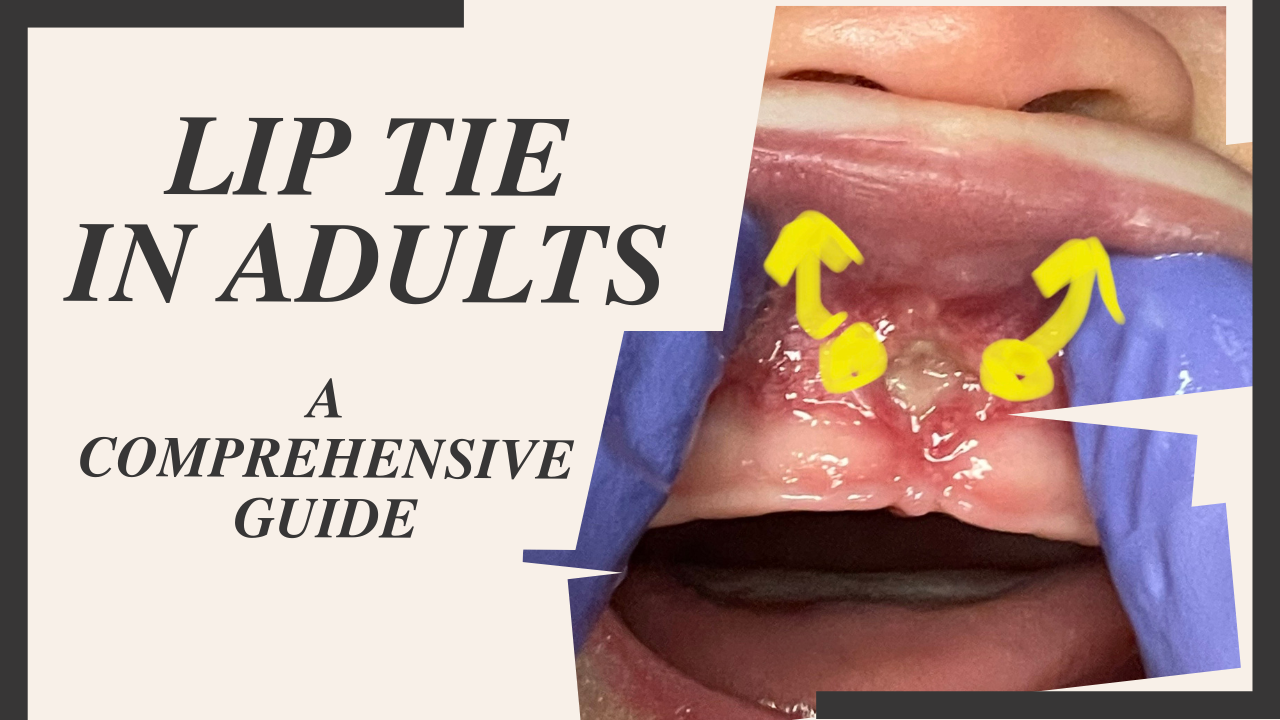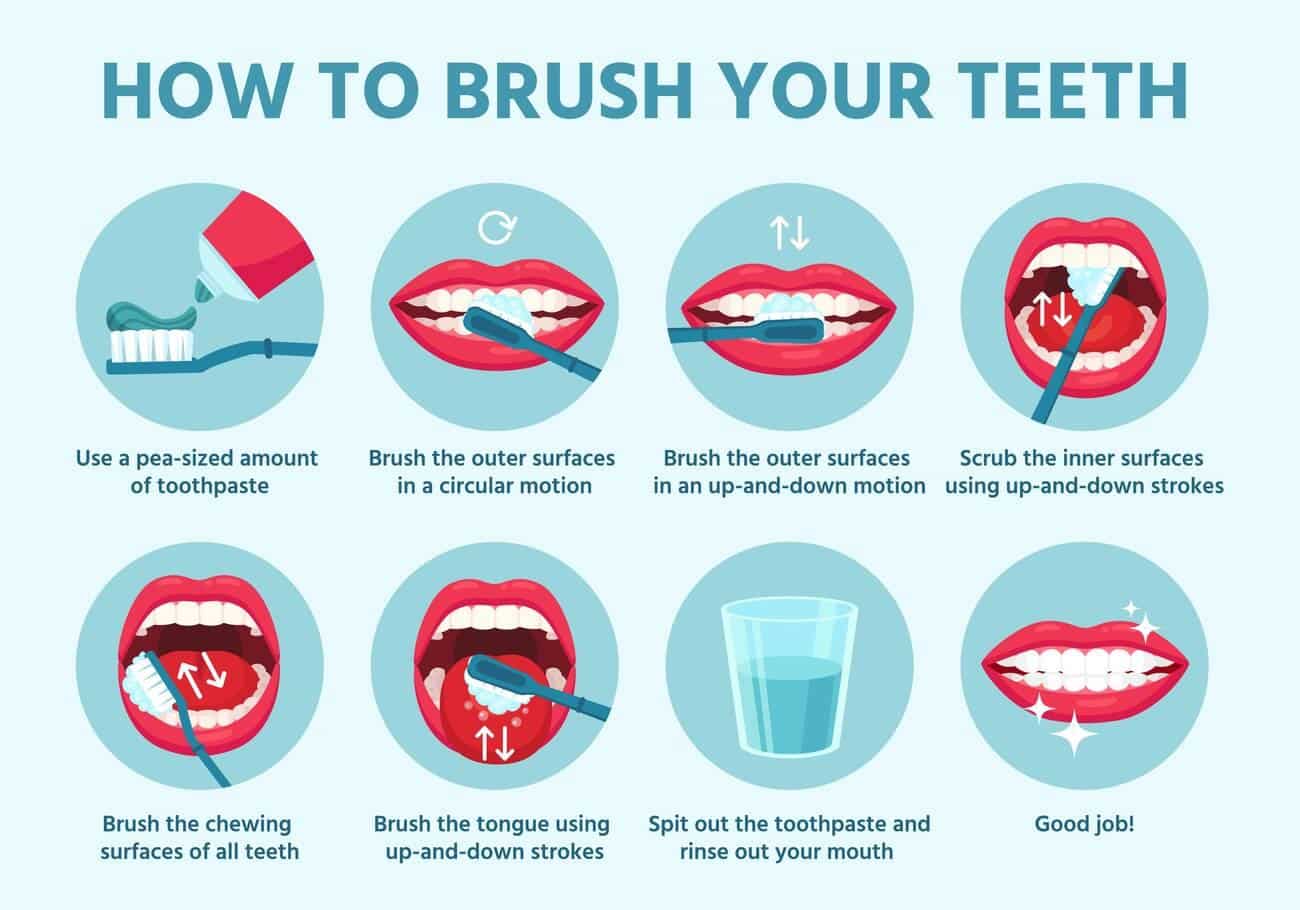Are you an adult struggling with lactation, eating issues, or jaw pain? Lip ties might be the problem. Lip tie is a condition where the tissue attaching the upper lip to the gums is shorter and tighter than normal. With proper diagnosis and treatment in adults, it can go a long way to treating underlying symptoms.
This comprehensive guide will inform you all about understanding lip tie in adults, including its causes, signs/symptoms, risks & complications of not being treated, and various types of treatments available for this condition.
Content Highlights
- Lip tie or ankyloglossia is a condition where the tissue attaching the upper lip to the gums is shorter and tighter than normal.
- Genetics, prenatal environment, and environmental factors can increase the risk of adults developing a lip tie.
- Eating difficulties, receding gums, head and neck tension, and sleep apnea are all signs of lip ties in adults.
- Treatment options such as frenectomy or frenuloplasty surgery can help alleviate issues surrounding this condition and improve overall health outcomes for both mother and baby by restoring good oral mechanics during nursing.
Understanding Lip Tie: What Is It?
A lip tie, also known as ankyloglossia, is an oral condition in which the tissue that attaches the upper lip to the gum (the frenulum) is abnormally short and tight. This can limit the range of motion for some babies’ lips and negatively affect breastfeeding.
In adults, a persistent or untreated lip tie can lead to poor dental hygiene habits, improper jaw alignment due to teeth grinding or clenching, difficulty speaking clearly, and object ingestion associated with snoring/sleep apnea.
It’s important for parents of newborns to be aware of signs that suggest their child has a lip tie so they are able to make informed decisions on seeking out treatment if needed.
What Causes Lip Tie in Adults and Newborns
Understanding the causes of lip ties in both newborns and adults can help people get the proper treatment they need for this condition.
Genetics
Genetics can play a key role in the formation of lip ties both in newborns and adults. Abnormal gene expressions combined with environmental influences can affect the development of oral tissues during fetal growth, potentially leading to an overly attached labial frenulum or lip tie.
Furthermore, certain genetic conditions such as infantile hypertrophic pyloric stenosis, holoprosencephaly, Ehlers-Danlos syndrome, and Marfan syndrome increase the risk for abnormal attachments of the labial frenulums or lips.
It is essential that these syndromes be diagnosed appropriately so the associated risks are better known and managed effectively. Undiagnosed genetic conditions or syndromes may present long-term problems, especially if left untreated for too long, resulting in dental issues like malocclusion later in life.
Unfortunately, many times lip ties go undiagnosed until adulthood when they cause difficulty eating or sleeping due to receding gums, for example, which could have been prevented had a diagnosis been made early on from birth depending on family genetics evaluation outcome providing potential warning signs of future risk scenarios prior even being born.
Prenatal Environment
The prenatal environment can play an important role in developing lip ties. While there is no definitive answer to determine which factors may contribute, some research suggests that certain prenatal environmental influences such as maternal nutrition, smoking, and exposure to specific medications or toxins can increase the risk for a lip tie in adults.
While researchers are still working on uncovering more detailed connections between prenatal environment and adult lip ties, it’s clear that these influences can affect how a baby develops before birth.
It’s worth noting that not everyone exposed to potential risk factors during pregnancy will develop a lip tie, so further study is needed to gain better insight into this area.
Environmental Factors
Environmental factors can also contribute to developing lip ties in newborns or adults. Genetics and certain aspects of the prenatal environment, such as labor and delivery, maternal health, nutritional deficiencies, or anemia during pregnancy, are all potential influences in developing a lip tie.
Additionally, external factors like premature birth and smoking during pregnancy can also play a role in this condition even after birth, depending on breastfeeding position adjustment.
This could lead to restriction of movement between the upper lip and gums while they are growing, causing them to attach more tightly than usual. Consequently, it may cause difficulty with breastfeeding since an inadequate latch might prevent proper suction at the mother’s breast leading to poor milk transfer along with other signs like receding gums over time.
Signs and Symptoms of Lip Ties in Adults
Lip ties in adults can often be identified by the presence of eating difficulties, receding gums, head and neck tension, and sleep apnea.
Eating Difficulties
Lip ties in adults can cause significant difficulty with eating. One major problem is the inability to properly chew food, which may lead to malnutrition and unhealthy weight loss.
Other difficulties include problems with swallowing or maintaining proper oral hygiene due to tightness of the fused upper lip connecting to the gum line. Individuals with lip ties may also experience recurrent pain or discomfort due to harm being done to their teeth structure as a result of improper chewing motion.
If left untreated, this could eventually lead to dental complications such as cavities, receding gums, jaw misalignment, and speech issues. While there are many treatment options for correcting lip ties in adults, like frenectomy and frenuloplasty surgery, it’s highly important that these individuals seek professional help from a qualified dentist so they can address any underlying medical concerns triggered by such condition early before further damage occurs thereby preventing long-term dental problems from manifesting in future years.
Receding Gums
Receding gums in adults can be a sign of lip ties, which is when the tissues and muscles between the upper lip and gum become overly tight or restrictive. Lip ties can create an imbalance of pressure that puts undue strain on teeth, leading to receding gums.
This restriction also makes it much harder for people with lip ties to maintain good oral hygiene since they cannot brush effectively. The intense balance of pressures caused by a lip tie has also been linked with other dental issues, such as cavities and misaligned teeth.
Fortunately, if detected early enough, adult lip tie sufferers have treatment options like frenectomy or frenuloplasty available that can reduce their symptoms and help them manage better oral hygiene practices without difficulty. Here are some tips for keeping your teeth and gums healthy.
Head and Neck Tension
Head and neck tension can be associated with signs of lip ties in adults, as a tight bond between the upper lip and gums can cause strain on the skull. This exertion may manifest itself as headaches, jaw pain, neck aches, or general discomfort in the area.
Lip ties are caused by overgrowth from the maxillary labial frenulum, which is the tissue between the upper lip and gums that, when overly developed, becomes attached too tightly to both structures.
A dental exam would need to be conducted to determine if there was an imbalance present from this attachment restricting movement within this region of the face.
Without treatment for this condition, recurring head and neck tension due to strained muscles along these joints could become continuous without resolution causing long-term physical issues overall impacting one’s quality of life negatively as well as poor oral hygiene due to difficulty brushing teeth properly stemming from a lack of mobility while doing so.
Sleep Apnea
Sleep apnea is a condition in which breathing pauses during sleep. Adults with lip ties may exhibit symptoms of this condition, such as snoring, gasping for air during sleep, and excessive daytime sleepiness.
The link between lip tie and sleep apnea is predicated on the possibility that the obstruction caused by a lip tie limits airflow to the upper airway while sleeping. Further research needs to be done to confirm if there’s an actual relationship between the two conditions, but some evidence suggests that treatment for lip ties via surgery (frenectomy or frenuloplasty) can potentially improve those with milder forms of sleep apnea.
Thus, correct diagnosis of lips tie, and its proper treatment is essential for individuals exhibiting signs of obstructive breathing patterns during their slumber.
How to Diagnose Lip Ties in Older Children and Adults
Diagnosing lip ties in adults involves a consultation with an experienced dental care provider who can perform both a visual and tactile examination.
Consultation With a Dentist
A dentist is essential for diagnosing and treating lip ties in newborns, as well as older children and adults. During the consultation, a dentist will examine the mouth to observe the latch and suck of a baby while breastfeeding.
In older children or adults, dentists can identify signs of lip tie such as tight or rigid attachments between lips and gums, loss of gum tissue between teeth due to poor brushing habits caused by the tightness of the tongue, misaligned teeth from chronic trauma, typically associated with an upper anterior crossbite (UACB).
The example is just one sign among many that are used for diagnosis.
Apart from examining symptoms related to oral health issues like dental problems driven by improper nutrition due to difficulties eating or even receding gums induced by excessive suction on account of drinking liquids through straws, etc., dentists can also provide information about treatments available if Lip Ties are identified.
Assessment of Symptoms
When assessing the symptoms of lip ties in older children and adults, a healthcare professional will typically start with a physical examination of the mouth. They’ll focus on evaluating dental and facial characteristics that could indicate a lip tie, such as receding gums, difficulty lifting their lips up, and lateral pressure on the lips to prevent them from closing properly when they’re relaxed.
In addition, they may observe individuals as they attempt to perform specific actions such as speaking, swallowing, or drinking liquids to assess any difficulty due to tongue tension caused by a lip tie.
X-rays can also be taken if necessary in order to get an even clearer picture of whether or not someone is suffering from this condition. It is important for people who are suspected of having lip ties to receive professional assessment in order to ensure that any potential risks or complications caused by untreated ties are identified at the earliest possible stage so treatment can be provided accordingly.
Risks and Complications of Untreated Lip Ties in Adults
Untreated lip ties can lead to difficulty with oral hygiene, potentially leading to dental problems, jaw misalignment, and speech issues.
Difficulties With Oral Hygiene
Lip ties in adults can create a variety of difficulties with oral hygiene. Without proper treatment, lip ties make brushing teeth challenging for adults due to the tightness of the tissue and its effect on overall mobility.
The inability to properly maneuver a toothbrush around the tight area can increase the risk of cavities, gum recession, plaque buildup, and other dental problems. Additionally, due to their limited range of motion, it may be difficult for adults with lip ties to effectively clean all areas of their teeth, resulting in further problems related to poor oral hygiene habits, such as bad breath and tooth decay.
As such, it is important for those affected by lip tie issues in adulthood to be aware that regular cleaning visits with both dentists and hygienists are necessary for controlling any potential complications that may arise from having a lip tie.
Dental Problems
Lip ties can have many consequences in adults if left untreated, including potential dental issues. According to the American Dental Association, lip ties are associated with an increased risk of cavities and misaligned teeth.
More severe attachments may even lead to receding gums when the skin attachment pulls away from the tooth it’s connected to. This tugging on the gum line can prompt inflammation and eventually damage or recession as the years go by.
What is more, lip tie-induced head and neck tension can also pull on other teeth causing them to move out of alignment. Altogether these problems all add up to significantly decreased oral health without proper diagnosis with treatment.
Jaw Misalignment
Lip ties in adults can obstruct proper jaw growth due to immature bone and tissue connections, resulting in misalignment. The upper lip tie restricts the full opening of the mouth area, while a lower lip tie limits closure and side-to-side alterations that are important for proper alignment.
In addition, gum recession from constant low-force tension on gums will further lead to malocclusion or crowding issues with teeth that are not straightly aligned or well proportioned.
When the mouth can’t move properly because the lips and tongue are restricted, it can cause overbites and underbites to become more common if not taken care of.
If this issue is not addressed for a long time, it can lead to various problems, like wearing down the back teeth and having a crowded bite that combines overbites and underbites, affecting digestion and speech. It can also cause dental issues like tooth decay and gum disease because it’s tough to clean the teeth properly.
Speech Issues
Lip ties in adults can lead to speech issues if left untreated. The tissue attaching the upper lip to the gums is too short and tight in cases of lip tie, which affects the movement and positioning of the tongue and lips.
This can manifest as difficulty forming certain consonant sounds – lisping or difficulty with words containing ‘s,’ ‘sh,’ or ‘z’ are common examples – as well as articulation issues resulting from an inability to use oral muscles properly.
Other difficulties that may arise due to lip ties include difficulties producing non-verbal vocalizations such as sighs or laughter, overly nasal voice production, and palate misalignment leading to crossovers between vowel sounds.
Treatment Options for Lip Ties in Adults
The main treatments used to address lip ties in adults include frenectomy and frenuloplasty techniques, designed to improve the health of both teeth and gums. Discover more about these procedures by exploring this comprehensive guide.
Frenectomy
[Video Credits @Joseph R Nemeth DDS]
Frenectomy is a surgical procedure to release the tight attachment between the lip and gums. It may be recommended for people with severe lip ties, which can interfere with breastfeeding and chewing as well as increase the risk of dental problems.
During a frenectomy, an incision is made in the tissue connecting the lips to the gum line, and excess tissue is removed from around the mouth area. Benefits of this procedure can include improved nursing ability, better oral hygiene, prevention of jaw misalignment, and improvement in speech difficulties caused by lip ties.
Some side effects, such as swelling, bleeding, or pain, might occur after undergoing it, but they are minor compared to potential long-term complications that can result from leaving a severe lip tie untreated. And if the frenectomy procedure goes wrong, this can ruin your beautiful smile for good. So, choose your surgeon wisely.
Frenuloplasty
Frenuloplasty is a surgical procedure to treat severe lip ties that extend into the palate. During the procedure, Osteotomes and lasers are used to release these attachments. Frenuloplasty can also be performed with local or general anesthetic depending on patient preference.
It’s important to note, however, that not all lip tie revisions require procedures such as frenuloplasty––some require simply stretching of the existing attachment through massage and exercises.
This can allow for improved movement while preventing further damage caused by repeat surgery or laser treatments over time.
When it comes to choosing an option, it’s best first to discuss your symptoms with a dental professional who specializes in mouth-related conditions so they can offer guidance based on your individual situation and preferences.
Additionally, It’s worth noting that experts have conflicting views about the benefits of lip tie revision via frenuloplasty—some suggest there is no benefit to this treatment, whereas others indicate possible improvements in breastfeeding rates post-procedure among babies with tongue/lip malformations merged together relatedly known as “tethered oral tissues”.
Post-Procedure Care
It is important for adults to care for their mouth following a lip tie revision properly. Immediately after the procedure, patients may experience some soreness and discomfort; however, these should subside in several days.
Healthcare providers give specific instructions after treatment. These may include using cold or warm compresses to reduce swelling, taking pain relievers like ibuprofen or acetaminophen as advised, avoiding acidic foods and drinks, and maintaining good oral hygiene by brushing and flossing regularly.
With proper post-procedure care, complete healing usually takes around two weeks time. Therefore it is important to follow all of the recommended instructions closely in order for the best outcome from treatment.
What to Expect During and After Lip Tie Treatment
During treatment, the clinician will typically use a specialized laser to break up bands of tissue that connect the lip or tongue with other structures in the mouth. Following the procedure, pain and swelling can occur at the site, but these normally subside after a few days.
Patients should be regularly monitored to ensure wound healing is progressing adequately.
Procedure Details
Frenectomy is the procedure typically used for treating lip tie in adults. This involves making a small incision to release the gums (gingiva) from the tissue that attaches them to teeth and lower lip, allowing greater mobility of these structures.
The procedure usually takes about 30 minutes and may be done under general or local anesthesia, depending on how extensive it needs to be. Before beginning the procedure, your dentist will take X-rays and examine your mouth to determine if you have any other issues that also need attention.
Surgery is only recommended if there are problems associated with the lip tie, such as difficulties with eating, receding gums, or sleep apnea caused by oral obstruction due to a tightly tethered lower lip.
After surgery has been completed, you may experience some discomfort which can include numbness around the operative site, facial swelling, and/or bruising near the operated area. This should resolve after a few days without treatment, but pain medications may also be prescribed accordingly when needed during this recovery time frame.
Recovery Process
After having a lip tie revision, the recovery process or healing period can generally be expected to last around one to two weeks. During this time, there may be some discomfort and even pain in the area treated.
After dental surgery, it’s crucial to follow your dentist’s instructions for a good recovery. These instructions usually involve:
- Gently rins the surgical area with salt water a few times daily.
- Staying away from crunchy foods like chips and candy.
- Using soft toothbrushes and oral hygiene tools.
- Applying ice if there’s swelling.
- Avoid strenuous activities like sports until you’re fully healed.
Post-operative care is an incredibly important step towards successful lip tie treatment in adults—by following all instructions closely, you can help facilitate quicker healing and faster relief from any associated symptoms.
Tips for Managing Discomfort
Post-procedure care for lip ties in adults should be carefully incorporated into the recovery process. Some tips to help manage discomfort during and after treatment include using an ice pack or cold compress on the area, rinsing with a warm salt solution, gently massaging the affected area, and drinking plenty of fluids.
Over-the-counter medications such as ibuprofen can also help reduce inflammation and pain during recovery. Avoiding carbonated beverages, nicotine products, spicy foods, and alcohol consumption may lessen irritation and burning sensation at the tongue tie release site.
Additionally, eating soft foods for several days while allowing adequate time for healing will aid in reducing any residual swelling or tenderness of the skin following frenectomy treatment.
Common Myths About Lip Ties in Adults
There are various myths and misunderstandings about lip ties in adults, including the belief that they don’t cause issues or can only be treated for cosmetic purposes.
01. Lip Ties Don’t Cause Issues in Adults
This is a common misconception as tongue ties, also known as ankyloglossia or lip ties, can cause many issues in adults. Lip ties refer to the short and thick bands of tissue that connect the inside of the lower lip to the floor of the mouth, and when they are too tight, they can restrict movement.
This restricts essential functions such as speaking properly, chewing food properly, and improper swallowing, which may lead to drooling and bad breath due to bacteria buildup under your tongue.
Furthermore, dental problems such as receding gums may develop from untreated lip ties in adulthood and possible jaw misalignment leading to further complications if left unaddressed.
02. Lip Tie Treatment Is Only for Cosmetic Purposes
This statement is false. Although lip tie revision surgery can improve a person’s physical appearance, there are numerous dental and health benefits too. Lip ties are caused by an abnormal degree of attachment between the lower gum tissue and the inner side of the upper lip; this causes problems with latch and seal while breastfeeding, has been linked to issues such as reflux in newborns, and may adversely affect teeth and gums if left untreated in adults.
Consequently, it may be recommended that people seek treatment for severe cases – usually through a procedure called a frenectomy or frenuloplasty. When performed correctly by an experienced professional, these procedures can have a significant impact on oral hygiene practices, often resulting in better breath control as well as improved eating habits due to allowing easier access to certain foods that would otherwise cause difficulties for patients with severe attachments.
In addition, they also reduce possible jaw misalignment concerns whilst improving speech clarity due to anatomical changes from the release of trauma-causing tensions around vital muscles within our face/neck region, which would otherwise remain unnoticed without addressing any underlying ties present.
03. Lip Tie Treatment Is Only for Babies
This myth is incorrect, as adults can also benefit from lip-tie treatment. Lip ties are a condition in which some or all of the frenum — the piece of tissue that connects the upper and lower lips to each other — is tight and shortened.
Though many people do not realize they have one, untreated lip ties in adults can cause problems with speech, eating, and oral hygiene due to the narrowing of their mouth opening. To address this issue in older children and adults, dentists may recommend a frenectomy or frenuloplasty procedure to improve function and range of motion.
The procedure usually only takes about 15 minutes under local anesthesia with no downtime afterward; however, soreness for 1 – 2 weeks is common after recovery from sedation anesthesia may take longer if used.
This discomfort should be managed carefully during healing with regular cleaning around incisions for a faster healing period while following post-procedure instructions given by the dentist, such as rinsing gently with warm salt water or taking over-the-counter medication when necessary.
Other Common Misconceptions About Lip Ties in Adults
Despite being more common in newborns, lip ties can also affect adults. Unfortunately, many people assume that adult lip tie symptoms are due to aging or wear and tear on the mouth rather than recognizing it as a specific condition.
Moreover, some mistakenly believe that rinsing and moisturizing with lotions or balms will be enough to resolve any issues stemming from this condition. Often, incorrect diagnosis is made because difficulty of visual identification – an understanding of what constitutes a severe lip tie in adults requires greater clinical skill since the attachment may appear thin even when creating significant problems.
The reality is that proper diagnosis requires assessment by a skilled clinician who can identify not just the presence of a lip tie but if it’s tight enough to warrant treatment – something that isn’t necessarily obvious without expert training.
Importance of Seeking Treatment for Lip Ties in Adults
Promptly treating lip ties in adults is crucial for long-term oral health, overall well-being, and quality of life.
Impact on Oral and Overall Health
Lip ties can be a serious issue for adults, as they can lead to difficulties with oral hygiene and dental problems. Even in mild cases, untreated lip ties can contribute to gingivitis or periodontal disease due to bacteria becoming trapped under an overlapped labial frenulum.
Severe lip tie attachments may even cause misalignment of the teeth during crushing force while eating and create cavities where food particles become stuck. Additionally, if an attachment is too severe, it may limit tongue movement, interfering with effective swallowing and leading to issues such as sleep apnea.
Furthermore, having a lip tie can also strain the jaw muscles leading to neck and head tension over extended periods of time, creating muscle aches that impact daily life activities without treatment.
Quality of Life Improvement
Lip ties in adults may have a serious and far-reaching impact on one’s quality of life. This is no surprise considering that lip ties can lead to pain and discomfort, speech issues, dental problems, difficulty breastfeeding, eating difficulties, head and neck tension, jaw misalignment, and sleep apnea.
With untreated lip ties placing an individual at risk of all these complications — as well as potentially impacting their self-esteem due to challenges with oral hygiene — seeking treatment for such issues should be considered essential.
Thankfully it is possible to achieve significant improvement through corrective treatments such as frenectomy or frenuloplasty when recommended by dentists or other healthcare professionals depending upon the severity of the condition.
The procedure involves removing or loosening some or all of the connective tissues that cause the tongue tie issue in question; this makes it possible for individuals to gain greater mobility and freedom with regard to speaking clearly or more comfortably swallowing food.
Wrapping Up
In conclusion, lip ties in adults can have far-reaching effects on oral and overall health. Early detection and treatment can help improve the quality of life and reduce pain and discomfort associated with the condition.
Lip ties are often considered a condition found mainly in newborns and infants. However, lip ties can occur in adults too, and, if left untreated, can have serious health implications.
Lip ties involve the lower labial frenulum – the thin membrane connecting the inner surface of the bottom lip to either side of the base of front teeth – that is either overly tight or excessively short and restricts movement and function of the lips.
In addition to difficulty breastfeeding for both mother and baby, having a lip tie can have an effect on oral hygiene problems such as receding gums, dental decay, jaw misalignment, and speech impediments later in life.
As with any medical issue, understanding what it is and being able to spot its signs enable individuals to seek out proper treatment if necessary. Early identification could potentially save countless trips to dentists’ offices farther down the road due to not only expenditures associated with care but also emotional stress caused by living with limited quality-of-life brought by unresolved issues connected with face under normal conditions never seen from the inside out until problems start appearing again sometime decades after the initial occurrence or first tooth eruption.
Disclaimer: This content is for informational purposes only and does not replace professional medical advice, diagnosis, or treatment. This information is not comprehensive and should not be used to make health or well-being decisions. Consult a qualified healthcare professional with questions about a medical condition, treatment options, or health regimen. This website or the content should never replace professional medical advice.










































